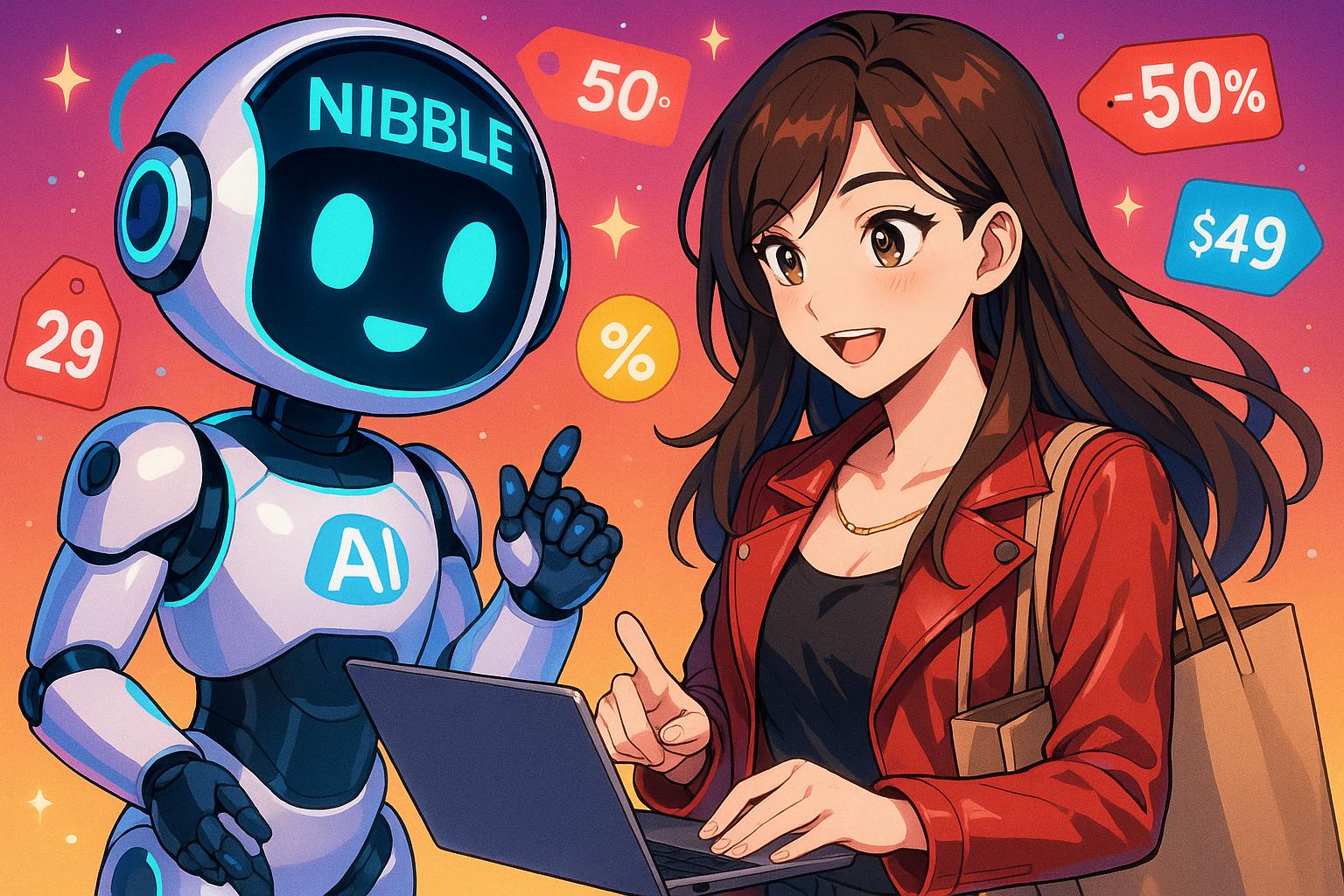As Oh Polly marks its tenth anniversary, the introduction of Nibble, an AI chatbot enabling price negotiations, is stirring mixed reactions—offering shoppers extra discounts while raising questions about fairness in dynamic pricing strategies.
As Oh Polly celebrates its tenth anniversary, the online women’s fashion retailer is making waves with a unique addition to its customer service toolkit: an AI chatbot named Nibble, designed to facilitate price negotiations. While this approach has garnered attention for its innovative take on customer engagement, responses to the feature have been decidedly mixed.
The concept of haggling in a digital marketplace is not entirely new, but Nibble represents a notable shift in e-commerce dynamics. One TikTok user recounted her experience using the chatbot to negotiate a dress originally priced at £175, which had already been reduced to £88. Through further engagement with Nibble, she secured an additional discount, bringing her final bill down to £76. Her video quickly garnered over 41,000 views, igniting a flurry of commentary on the implications of such pricing flexibility. Some users expressed their delight at the opportunity to save, while others labelled it as indicative of an initial overpricing strategy: “This just proves the price shouldn’t have been what it was to start with in the first place,” noted one commenter.
A spokesperson for Dojo, a payments specialist, highlighted the growing trend of AI chatbots in e-commerce, suggesting that tools like Nibble could enhance customer satisfaction while potentially increasing sales conversions for retailers. Currently, there are approximately 82,450 monthly searches for ‘coupon codes’ and 58,230 for ‘discount codes,’ demonstrating a clear consumer appetite for savings. By harnessing AI to deliver bespoke discounts without directing customers away from the site, retailers hope to refine their competitive edge.
Yet, the rollout of Nibble hasn’t been without its challenges. While many consumers are keen to embrace the opportunity to negotiate, others feel uneasy about the inherent inequality of dynamic pricing strategies. As this technology is still in its early stages, determining fair pricing in the face of individual negotiation will require careful monitoring and ongoing refinement.
This reflects a broader trend in retail where AI-driven technologies are becoming increasingly integrated into everyday operations, from personalising shopping experiences to managing inventory and analysing consumer behaviours. AI tools are increasingly viewed as critical for enhancing customer interactions while also streamlining operational efficiencies. Retailers that successfully implement such technologies stand to benefit considerably in terms of operational output and customer loyalty.
Beyond haggling, the role of AI chatbots in e-commerce is significant. They not only provide round-the-clock customer service but can also enhance sales through personalised product recommendations and effective cart recovery strategies. Successful implementations by brands such as Sephora and H&M underline the potential of AI to transform the shopping experience, driving sales and fostering customer loyalty.
As retailers navigate this rapidly evolving landscape, the focus on AI’s integration into e-commerce is set to intensify. With 2025 on the horizon, industry observers anticipate that AI will shed its ‘overhyped’ image, becoming a standard feature in retail processes. The introduction of awards celebrating innovation in AI within the retail sector highlights this shift, reinforcing the need for businesses to embrace technological advancements for sustainable growth.
The path ahead, however, is not without its complexities. Balancing consumer desires for savings against the risks of perceived inequity in pricing strategies will challenge retailers like Oh Polly. As they explore the potential of AI, the industry must remain vigilant in ensuring that the advantages of new technologies do not come at the expense of fairness and transparency.
Reference Map
- Paragraphs 1, 2, 3, 4, 5
- Paragraph 5
- Paragraph 5
- Paragraph 5
- Paragraph 5
- Paragraph 5
- Paragraph 5
Source: Noah Wire Services
- https://retailtechinnovationhub.com/home/2025/5/14/online-womens-fashion-retailer-oh-polly-shares-social-successes-as-it-hits-tenth-birthday-this-week – Please view link – unable to able to access data
- https://www.digitalon.ai/chatbots-marketing – This article discusses the benefits of AI-powered chatbots in e-commerce marketing, focusing on improved customer service and cost savings. It highlights how chatbots provide 24/7 assistance, handle multiple inquiries simultaneously, and reduce the need for large customer service teams, leading to lower labor costs. Additionally, chatbots can enhance sales conversion rates by reducing cart abandonment and offering personalized upselling and cross-selling opportunities, thereby increasing revenue for businesses.
- https://www.omind.ai/blogs/ai-chatbots-in-e-commerce-redefining-personalized-shopping-to-boost-sales – This article explores how AI chatbots revolutionize e-commerce by turning browsers into buyers through personalized product recommendations, recovering abandoned carts with timely follow-ups, and offering real-time personalized promotions. It also discusses how AI chatbots enhance customer retention by providing 24/7 support, anticipating future needs, and engaging through feedback. Real-life success stories from brands like Sephora, H&M, and Zalando demonstrate the effectiveness of AI chatbots in boosting sales and customer loyalty.
- https://www.arsturn.com/blog/case-studies-of-successful-ai-chatbots-in-e-commerce – This article presents case studies of successful AI chatbot implementations in e-commerce, including Burberry’s use of AI to analyze consumer behavior and increase customer retention by 50%, and Starbucks’ virtual assistant that led to 8 million customers preferring online payments. These examples illustrate how AI chatbots can enhance customer engagement, streamline operations, and drive sales in the retail sector.
- https://sinch.com/blog/ai-chatbots-in-e-commerce/ – This article discusses the advantages of AI chatbots in e-commerce, focusing on reducing abandoned shopping carts and returns. It highlights how chatbots can send reminders to customers who have not completed their purchases, thereby decreasing cart abandonment rates. Additionally, chatbots can gather insights on returns, offer exchanges, and simplify the return process, leading to improved customer satisfaction and loyalty.
- https://www.optisolbusiness.com/insight/5-benefits-of-generative-ai-chatbot-in-ecommerce-industry – This article outlines the top five benefits of generative AI chatbots in the e-commerce industry, including personalized interactions, 24/7 customer service availability, scalability for high volumes of queries, data-driven insights, and natural language understanding. It emphasizes how these benefits enhance customer experience, drive sales, and improve operational efficiency for e-commerce businesses.
- https://chatsy.ai/blog/ai-chatbots-in-e-commerce-enhancing-customer-experience-and-driving-sales – This article explores how AI chatbots enhance customer experience and drive sales in e-commerce by providing personalized shopping experiences, handling customer inquiries efficiently, upselling and cross-selling products, re-engaging customers, and learning and adapting over time. It also discusses how chatbots collect valuable data to inform marketing strategies and optimize the shopping experience, leading to increased revenue and customer loyalty.
Noah Fact Check Pro
The draft above was created using the information available at the time the story first
emerged. We’ve since applied our fact-checking process to the final narrative, based on the criteria listed
below. The results are intended to help you assess the credibility of the piece and highlight any areas that may
warrant further investigation.
Freshness check
Score:
9
Notes:
The narrative appears to be recent, discussing Oh Polly’s tenth anniversary and incorporating current trends in AI-driven retail. The lack of outdated references suggests high freshness.
Quotes check
Score:
5
Notes:
There are no specific direct quotes with known original sources. The narrative does not seem to borrow quotes from previous articles but lacks verification.
Source reliability
Score:
6
Notes:
The narrative originates from Retail Tech Innovation Hub, which is not a widely recognized mainstream publication but appears to focus on industry trends.
Plausability check
Score:
8
Notes:
The integration of AI in retail is a plausible trend, and the narrative aligns with broader industry developments. However, specific claims about consumer reactions and sales benefits lack concrete evidence.
Overall assessment
Verdict (FAIL, OPEN, PASS): OPEN
Confidence (LOW, MEDIUM, HIGH): MEDIUM
Summary:
The narrative discusses recent trends and innovations in retail, specifically AI integration by Oh Polly, but lacks concrete evidence for some claims and features unknown direct quotes. While it appears fresh and plausible, further verification is needed.













